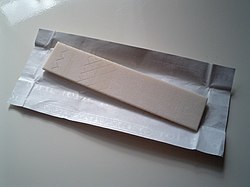Chewing-gum

An unwrapped stick of chewing gum
|
|
| Type | Confectionery |
|---|---|
| Main ingredients | gum base, sweeteners, plasticizers, flavors, colors, polyols |
| |
|
Chewing gum is a soft, cohesive substance designed to be chewed without being swallowed. Modern chewing gum is composed of gum base, sweeteners, softeners/ plasticizers, flavors, colors, and, typically, a hard or powdered polyol coating. Its texture is reminiscent of rubber because of the physical-chemical properties of its polymer, plasticizer, and resin components, which contribute to its elastic-plastic, sticky, chewy characteristics.
The cultural tradition of chewing gum seems to have developed through a convergent evolution process, as traces of this habit have arose separately in many of the early civilizations. Each of the early precursors to chewing gum were derived from natural growths local to the region and were chewed purely out the instinctual desire to masticate. Early chewers did not necessarily desire to derive nutritional benefits from their chewable substances, but at times sought taste stimuli and teeth cleaning or breath-freshening capabilities.
Chewing gum in many forms has existed since the Neolithic period. 6,000-year-old chewing gum made from birch bark tar, with tooth imprints, has been found in Kierikki in Finland. The tar from which the gums were made is believed to have antiseptic properties and other medicinal benefits. It is chemically similar to petroleum tar and is in this way different from most other early gum. The Aztecs, as the ancient Mayans before them, used chicle, a natural tree gum, as a base for making a gum-like substance and to stick objects together in everyday use. Forms of chewing gums were also chewed in Ancient Greece. The Ancient Greeks chewed mastic gum, made from the resin of the mastic tree. Mastic gum, like birch bark tar, has antiseptic properties and is believed to have been used to maintain oral health. Both chicle and mastic are tree resins. Many other cultures have chewed gum-like substances made from plants, grasses, and resins.
...
Wikipedia
